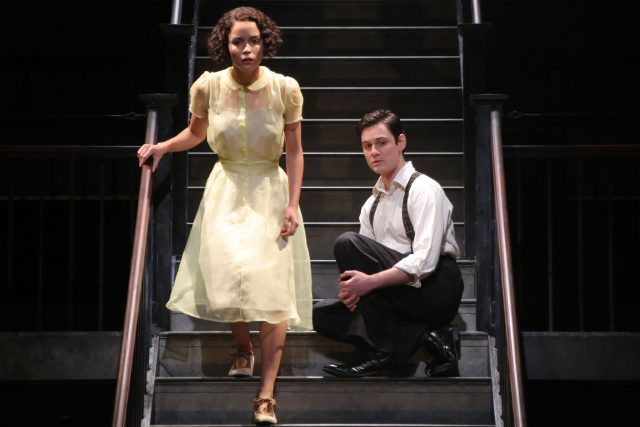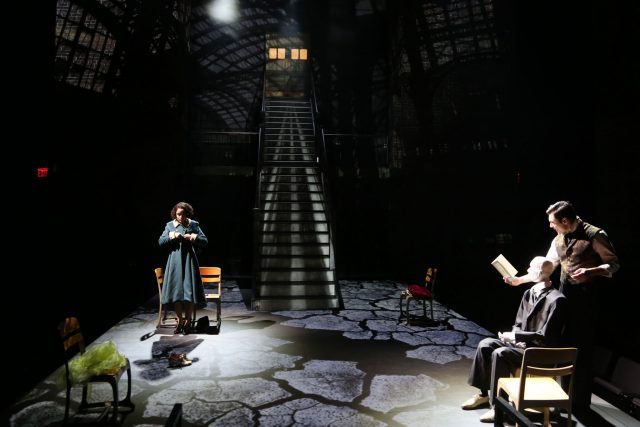
Kay (Juliana Canfield) and Christopher (Tom Pecinka) battle racism in the Jim Crow south in He Brought Her Heart Back in a Box (photo by Gerry Goodstein)
Theatre for a New Audience, Polonsky Shakespeare Center
262 Ashland Pl. between Lafayette Ave. & Fulton St.
Tuesday – Sunday through February 11, $90-$125
866-811-4111
www.tfana.org
In 2016, the Signature presented a powerful revival of Adrienne Kennedy’s Obie-winning debut play, 1964’s Funnyhouse of a Negro, as part of a trio of experimental one-act plays, with Edward Albee’s The Sandbox and María Irene Fornés’s The Drowning. Now Theatre for a New Audience is staging the world premiere of the eighty-six-year-old Kennedy’s first play in nine years and first solo-written drama in two decades, He Brought Her Heart Back in a Box, which opened last night and deals with many of the same issues, focusing on generations of Americans affected by Jim Crow laws and institutional racism, and it feels like not a moment too soon nor a moment too late. Inspired by events in her own life and featuring snippets from Noël Coward’s Bitter Sweet and Christopher Marlowe’s The Massacre at Paris, the fifty-minute show is set in the fictional town of Montefiore, Georgia, in June 1941, where Christopher (Tom Pecinka), son of successful white businessman Harrison Aherne and a white woman — Harrison also has three young children by three black women — and Kay (Juliana Canfield), the daughter of a white writer and a black woman who died mysteriously shortly after Kay was born, have declared their desire for each other. The two seventeen-year-olds know their love is forbidden so they keep it a secret as Christopher leaves for New York City to pursue a stage career and they exchange letters. “He just knew these things. He understands history. He understands the devastation of the human spirit,” Chris writes about his father. “He knows the importance of making a person enter through the back door and of never addressing them as you are addressed. He understands how language can be used to humiliate.” Kay writes back, “My grandmother always said we saw my father all the time on Main Street but he never looked our way. My grandmother said, ‘Your father would look away but his mother would look at you like she was going to kill you right there.’” Meanwhile, Christopher begins to question his father’s friendship with Germans as WWII spreads around the world and is about to involve America. As they continue writing letters and planning their marriage, they traverse Christopher Barreca’s breathtaking set, a floor with several chairs, one of which is occupied by a life-size puppet representing Harrison Aherne. A long stairway leads up to a closed door; on either side are huge brick barriers. Video designer Austin Switser projects images on the floor, walls, and steps of two trains, one for blacks, one for whites; signs in waiting rooms and at water fountains declaring “White” and “Colored”; and photographs further displaying differences in class and race embodied by Christopher and Kay’s relationship.

Adrienne Kennedy’s He Brought Her Heart Back in a Box is a haunting memory play about childhood, first love, and Jim Crow (photo by Gerry Goodstein)
Kennedy (Sleep Deprivation Chamber, June and Jean in Concert), who lived in New York for thirty years before moving to Virginia six years ago to be with her son, Adam, her collaborator on several plays, looks directly at racism and segregation and the lasting effects of slavery in He Brought Her Heart Back in a Box, as the history of two families becomes a microcosm for societal ills that sadly continue to be crucial sources of pain in American life today. It’s a dark fairy tale ably guided by Obie-winning director Evan Yionoulis (The Violet Hour, Three Days of Rain), who helmed the Lortel Award-winning TFANA revival of Kennedy’s Ohio State Murders in 2007. Despite its often confusing and fragmentary narrative, which eschews contemporary realism, Pecinka and Canfield, in her professional New York stage debut, are tantalizing together, striking surprisingly emotional chords as Kay and Christopher’s Romeo-and-Juliet-style love grows. The play is exceedingly angry and at times agonizingly personal, as if we are meeting Kennedy’s inner demons, as if she knew what she wanted to say and got right to the point, unconcerned with conventional plot and character development. (She wrote the play for her grandson after watching him graduate from a Virginia high school, feeling that not much had changed since the 1950s.) But there are also transcendent moments of pure poetry as Kennedy illuminates the sheer hatred that lies at the heart of racism. As you enter the theater, be sure to stop by the miniature model of the gray, dank Montefiore town, devoid of people, as if haunted, with tiny segregation signs at a water fountain and in the train station waiting room. As Kennedy demonstrates, one possible future is that there will ultimately be no one left, neither blacks nor whites, all victims of fear, jealousy, and the violence that comes with that.